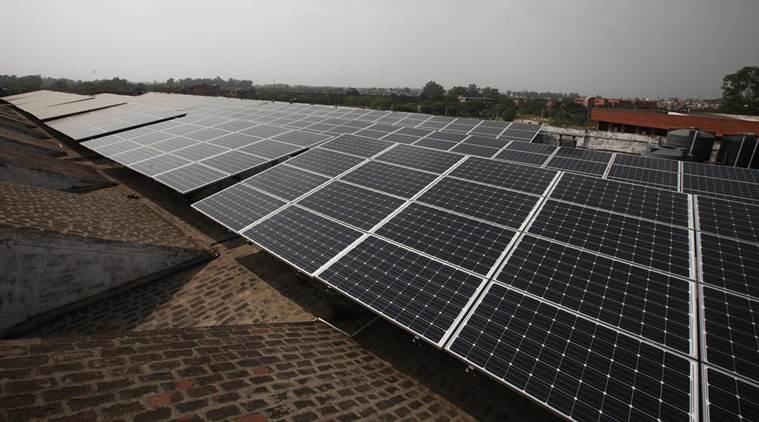 In the short-term, it’s crucial to ascertain how to respond to extreme heat and urbanisation challenges during a major pandemic. (Express Photo by Kamleshwar Singh/Representational Image)
In the short-term, it’s crucial to ascertain how to respond to extreme heat and urbanisation challenges during a major pandemic. (Express Photo by Kamleshwar Singh/Representational Image)
India is among the most rapidly urbanising countries in the world. In 2018, nearly 34 per cent of the country’s population lived in the cities — this is expected to increase to 40 per cent by 2030, contributing 75 per cent of the GDP. Driven by growing urbanisation, the real estate sector — which is the second-largest employer after agriculture and contributed 6-7 per cent of the GDP in 2017 — will increase to 13 per cent by 2025, notwithstanding temporary setbacks due to the pandemic.
The exponential growth in urbanisation implies using up most of the open spaces in urban and semi-urban areas and creating more of paved surface cover, heat-trapping roofs, buildings and roads. Often, buildings are one of the major contributors to incremental heat generation. More than 60 per cent of the roofs are made of concrete, metal and asbestos, all of which tend to trap heat. Over time, these hot surfaces worsen the heat island effect and drive temperatures higher. Further, buildings account for more than 30 per cent of India’s electricity consumption and a significant share of annual carbon dioxide emissions. It is thus imperative that any effort towards energy conservation must include a focused approach to urban areas and more specifically on buildings and built-up areas.
Hyderabad has been rated as the best city in India in the Mercers Quality of Living Index for the last six years. Hyderabad, since the second quarter of 2019, is also the fastest-growing real estate market in the country. The commercial/institutional office space, which was 100 million square feet in 2015, is likely to double by 2021.
In the short-term, it’s crucial to ascertain how to respond to extreme heat and urbanisation challenges during a major pandemic. In the medium and long-term, we need proactive pre-disaster actions to reduce risk and to invest in forward-looking plans, policies and programmes to ensure we make the right choices to balance urban growth and sustainable development.
In the context of the urban built-up space, there is an opportunity upfront by ensuring the buildings are built smart. Telangana has taken steps to ensure energy efficiency in its buildings by incorporating the Bureau of Energy Efficiency (BEE)’s Energy Conservation Building Code (ECBC), which sets minimum efficiency standards for all commercial buildings, including categories such as multiplexes, hospitals, hotels and convention centres which have a plot size of 1,000 sq meters or a built-up area of 2,000 sq meters or more. Additionally, the state has included mandatory ECBC and green building codes, under section 176(4) in the newly promulgated Telangana Municipality Act 2019. This will go a long way in ensuring the environmental footprint of the sector is controlled.
Additionally, there exist low-cost solutions to reduce the heat stress in homes and offices and bring down the dependence on air conditioners.
Cool roofs, for example, offer a simple and a cost-effective answer to urbanisation challenges. Cool roofs reflect sunlight and absorb less heat. Depending on the setting, they can help lower indoor temperatures by 2 to 4 degrees Celsius as compared to traditional roofs. These roofs also potentially lead to less air pollution since they save energy, especially on cooling appliances, such as fans and air conditioners.
The Government of Telangana, realising the importance of low-cost cool-roofing technology, has already undertaken several meaningful interventions.
Telangana tested these technologies through pilots undertaken in 2017. As part of the state’s building energy efficiency programme, the Greater Hyderabad Municipal Corporation (GHMC) partnered with the Administrative Staff College of India (ASCI), International Information Institute for Technology-Hyderabad (IIIT-H), and Natural Resources Defence Council (NRDC) to implement a cool roofs pilot in low-income neighbourhoods to showcase the benefits and impact of cool roofs in the city. The project focused on a set of 25 low-income households. Dupont India supplied a high-density polyethylene (HDPE) cool roof coating membrane called Tyvek. The results found that indoor air temperatures were observed to be lower by an average of 2 degrees Celsius in the homes with cool roofs as compared to similar homes without cool roofs. Working with knowledge partners, the Telangana Cool Roofs Programme has been designed and is ready for implementation. The programme is a target-based initiative to increase the percentage of cool roofs in the state. The programme will aim to install cool roofs in low-income housing and slum communities in the initial years, where the thermal comfort of the occupants is of paramount importance.
Commercial buildings are also an important segment, given the rising footprint of the commercial activity in the state. While cool roofs have already been included in the prescriptive requirements of the state’s energy conservation building code, the government will eventually look to mandate the adoption in the latter years of the programme.
A robust awareness generation and capacity building campaign is also a part of the programme. While it is important to focus on targets, the realisation of those targets has to be ensured through a well-functioning ecosystem of suppliers and installers. What is required at this stage is large scale marketing of the concept to make builders and owners aware of the advantages in terms of energy and cost savings.
This article first appeared in the print edition on July 11, 2020 under the title ‘Cool roofs and other solutions’. Kumar is Principal Secretary, Municipal Administration and Urban Development, Government of Telangana. Bilolikar is associate professor, Centre for Energy Studies, Administrative Staff College of India (ASCI), Hyderabad.